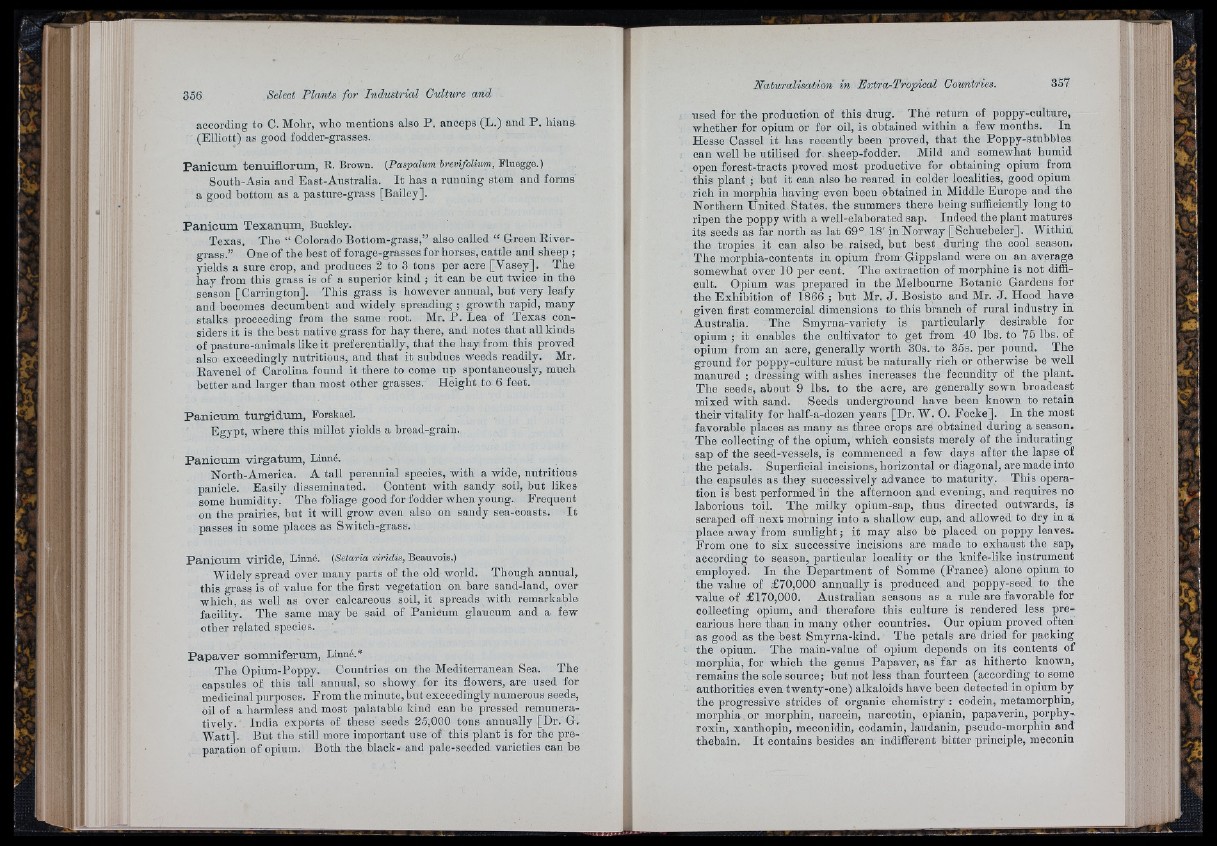
aecording to C. Mohr, who mentions also P. anceps (L.) and P . hians-
(Elliott) as good fodder-grasses.
Panicum tenuiflorum, R. Brown. (Paapcdum hrevifolium, Fluegge. )
Sonth-Asia and East-Australia. I t has a running stem and forms
a good bottom as a pasture-grass [Bailey].
Panicum Texanum, Buckley.
Texas. The “ Colorado Botlom-grass,” also called “ Green River-
grass.” One of the best of forage-grasses for horses, cattle and sheep ;
yields a sure crop, and produces 2 to 3 tons per acre [Vasey]. The
hay from this grass is of a superior kind ; it can he cut twice in the
season [Carrington]. This grass is however annual, but very leafy
and becomes decumbent and widely spreading ; growth rapid, many
stalks proceeding from the same root. Mr. P . Lea of Texas considers
it is the best native grass for hay there, and notes th a t all kinds
of pasture-animals like it preferentially, th a t the hay from this proved
also exceedingly nutritious, and th a t it subdues weeds readily. Mr.
Ravenel of Carolina found it there to come np spontaneously, much
better and larger than most other grasses. Height to 6 feet.
Panicum turgidum, Forskael.
Egypt, where this millet yields a hread-grain.
Panicum virgatum, Linné.
North-Amerioa. A tall perennial species, with a wide, nutritious
panicle. Easily disseminated. Content with sandy soil, but likes
some humidity. The foliage good for fodder when young. Frequent
on the prairies, but it will grow even also on sandy sea-coasts. I t
passes in some places as Switch-grass.
Panicum viride, Linné. (Setaria viridis, Beauvois.)
Widely spread over many parts of the old world. Though annual,
this grass is of value for the first vegetation on bare sand-land, over
which, as well as over calcareous soil, it spreads with remarkable
facility. The same may be said of Panionm glancum and a few
other i-elated species.
Papaver somniferum, Linné.*
The Opium-Poppy. Countries on tbe Mediterranean Sea. The
capsules of this tall annual, so showy for its flowers, are used for
medicinal purposes. From the minute, but exceedingly numerous seeds,
oil of a harmless and most palatable kind can be pressed remuneratively.
India exports of these seeds 25,000 tons annually [Dr. G,
W a tt]. But the still more important use of this plant is for the preparation
of opium. Both the black- and pale-seeded varieties can be
used for the production of this drug. The return of poppy-culture,
whether for opium or for oil, is obtained within a few months. In
Hesse Cassel it has recently been proved, th a t the Poppy-stnhbles
can well be utilised for sheep-fodder. Mild and somewhat humid
open forest-tracts proved most productive for obtaining opium from
this plant ; but it can also be reared in colder localities, good opium
rich in morphia having even been obtained in Middle Europe and the
Northern United States, the summers there being sufficiently long to
ripen the poppy with a well-elaborated sap. Indeed the plant matures
its seeds as far north as lat 69° 18' in Norway [Schuebeler]. Within
the tropics it can also be raised, bnt best during the cool season.
The morpliia-oontents in opium from Gippsland were on an average
somewhat over 10 per cent. The extraction of morphine is not difficult.
Opium was prepared in the Melbourne Botanic Gardens for
th e Exhibition of 1866 ; hu t Mr. J . Bosisto and Mr. J . Hood have
given first commercial dimensions to this branch of rural industry in
Australia. The Smyrna-variety is particularly desirable for
opium ; it enables the cultivator to get from 40 lbs. to 75 lbs. of
opium from an acre, generally worth 30s. to 3os. per pound. The
ground for poppy-culture must be naturally rich or otherwise be well
manured ; dressing with ashes increases the fecundity of the plant.
The seeds, about 9 lbs. to the acre, are generally sown broadcast
mixed with sand. Seeds underground have been known to retain
their vitality for half-a-dozen years [Dr. W. O. Focke]. In the most
favorable places as many as three crops are obtained during a season.
The eolleoting of the opium, which consists merely of the indurating
sap of the seed-vessels, is commenced a few days after the lapse of
the petals. Superficial incisions, horizontal or diagonal, ai-e made into
the capsules as they successively advance to maturity. This operation
is best performed in the afternoon and evening, and requires no
laborious toil. The miiky opium-sap, thus directed outwards, is
scraped off next morning into a shallow cup, and allowed to dry in a
place away from su n lig h t; it may also he placed on poppy leaves.
From one to six successive incisions are made to exhaust the sap,
according to season, particular locality or the knife-like instrument
employed. In the Department of Somme (France) alone opium to
the value of £70,000 annually is produced and poppy-seed to the
value of £170,000. Australian seasons as a rule are favorable for
collecting opium, and therefore this culture is rendered less precarious
here than in many other countries. Our opium proved often
as good as the best Smyrna-kind. The petals are dried for packing
the opium. The main-value of opium depends on its contents of
morphia, for which the genus Papaver, as far as hitherto known,
remains the sole source; but not less than fourteen (according to some
authorities even twenty-one) alkaloids have been detected in opium by
the progressive strides of organic chemistry : codein, metamorphin,
morphia or morphin, narcein, narcotin, opianin, papaverin, porphy-
roxin, xanthopin, meoonidin, codamin, laudanin, pseudo-morphin and
thebain. I t contains besides an indifferent bitter principle, meconin